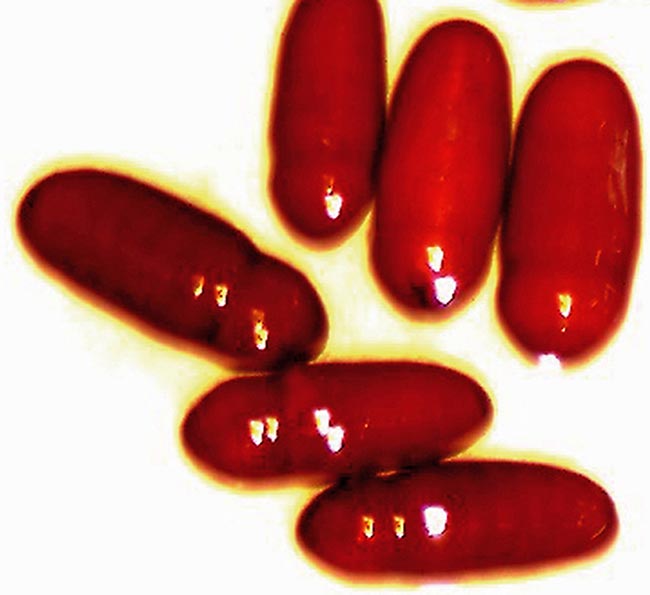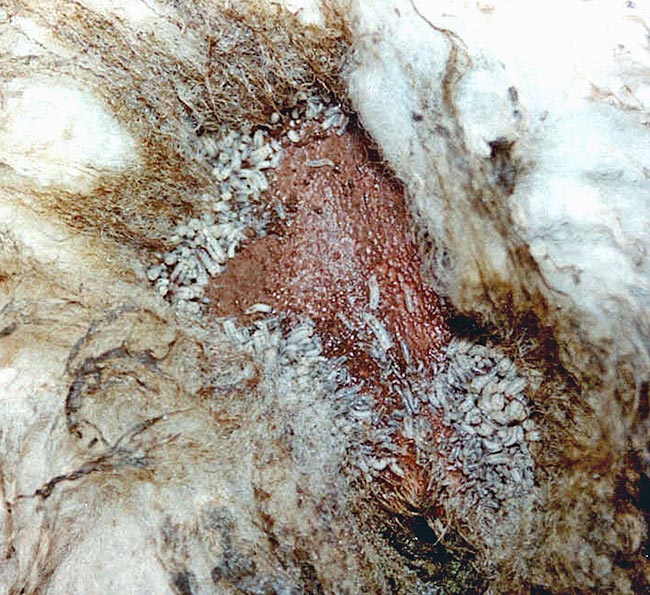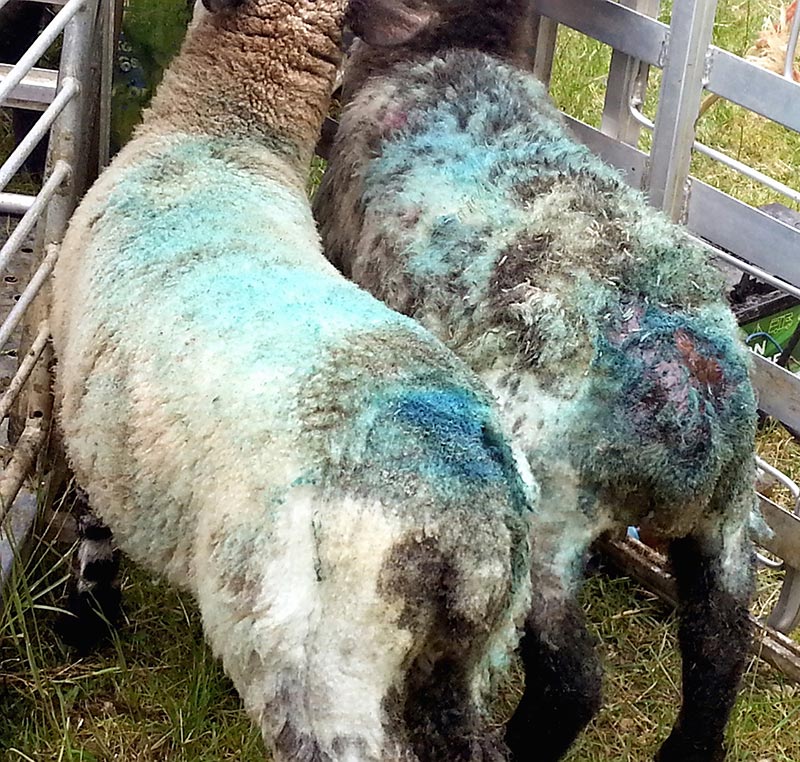30 Jul 2018
Hany Elsheikha considers the circumstances and source of this disease, including optimal timing for prevention and treatment.

Image © Richard Wall
Fly strike, or cutaneous myiasis, is caused by blowfly larvae of the genus Lucilia (order Diptera, family Calliphoridae) and is a significant challenge for sheep breeders – especially in major sheep-producing countries. Blowfly maggots attack sheep skin, where they feed on tissue and cause severe skin injury. A painful condition, such as fly strike, should be actively monitored and effectively managed to prevent productivity losses, and ensure good animal welfare. Although blowflies are aggressive and notoriously difficult pests to control, fly strike can be a preventable condition.
Methods used to control blowfly infestation rely on the use of pharmacological treatments, in combination with other supportive measures. A better understanding of the seasonal pattern of strike occurrence, together with the careful evaluation of the influence of risk factors that contribute to the emergence of blowflies (including fly abundance, warm and wet weather, scouring and faecal soiling, and fleece length), are the basis of a sound plan to achieve effective fly strike control. The aim of this article is to discuss the key risk factors that influence the incidence of fly strike in sheep and to present the various means available to sheep farmers to effectively protect their livestock from blowfly infestation.
Myiasis is a pathological condition caused by the infestation of living tissues with the larvae of certain fly species.

Many fly species are responsible for the various forms of myiasis. Flies of the genus Lucilia (Figure 1) are of great medical and veterinary importance as they can cause myiasis in humans and animals – principally sheep. Blowfly strike in sheep is a form of myiasis caused by the facultative (can develop on carrion, in addition to live hosts) species Lucilia sericata (order Diptera, family Calliphoridae) in the UK (Wall, 2012), and in north-west and central Europe, and the obligate species Wohlfahrtia magnifica – mainly in central and southern Europe. Lucilia cuprina is responsible for strike in sheep in Australia.
In this article I will discuss the severity and implications of fly strike caused by infestation of sheep skin with L sericata larvae. Additionally, I discuss methods of treatment and prevention to help control the disease.

Fly strike occurs when flies lay their eggs in a sheep’s wool. Flies can lay up to 3,000 eggs in a three-month period. When the eggs hatch, the maggots start eating into the sheep’s skin and flesh. Female flies oviposit their ova in a wet fleece – particularly around the backside of the animal, often concurrently with the presence of a bacterial infection and fleece rot.
Strike can develop relatively quickly, with the first maggots appearing within 12 hours of the eggs being laid. After a period of time, the larvae drop off the host to form pupa (Figure 2) in the soil. The rapid development of blowflies from eggs deposited on the skin is quick – occurring over a few days.
Ovine fly strike frequently occurs at the tail head. However, other parts of the sheep’s body can be affected. An affected sheep will often isolate itself from the majority of the flock and may be seen itching with increased tail wagging. Sheep affected with blowfly strike can have disrupted grazing patterns and rapidly lose weight – especially if left untreated. Larvae may remain on the skin surface, causing relatively little damage, or may penetrate inwards.
Larger numbers of larvae are more dangerous as they will create a larger wound (Figure 3). The smell of infestation can attract more flies to feed on the flesh of sheep – causing more fleece loss, agonising pain, distress of the sheep, and, ultimately, toxic shock and death in neglected sheep (Colditza et al, 2005).

The feeding maggots cause considerable economic losses through decreased production and ruined hides. If not recognised and treated promptly, the disease can result in significant morbidity – and even mortality. Fly strike is estimated to affect 500,000 sheep per year (equivalent to 1.7 per cent of a national flock of 30 million) in England and Wales (French et al, 1992).
The cost of fly strike to the UK farming industry (including mortality, ongoing production losses, treatment and preventive costs) is estimated at £3,104,000, excluding the labour and time that goes into treating the condition (Bennett and Ijpelaar, 2003). Fly strike also occurs in Australia, New Zealand and South Africa. The cost of fly strike to the Australian economy is in excess of AUS$280 million each year – which includes mortalities, production losses, labour and insecticides.
Not all sheep in a flock are equally susceptible to fly strike. The infestation of sheep is strongly associated with a range of predisposing conditions, such as soiling of the fleece by urine and faeces (and associated bacterial contamination of these sites), endoparasitic worm burden, and associated diarrhoea, soiling of breech region, fleece length, fleece rot, and humidity – all of which promote oviposition and larval survival. Certain body conformational features can exacerbate these risk factors further, such as skin folds, obesity and fine, dense wool of lowland breeds.
Wet and warm weather conditions are key factors for creating perfect breeding conditions for blowflies. Rainy weather predisposes the sheep to blowfly infestation and fleece rot. Due to soiling, breech strikes are very common – accounting for 71 per cent of strikes in one survey of England and Wales (French et al, 1995).

Historically, blowfly strike control has relied on the use of insecticides – either to treat existing strikes, or to prevent strikes in various body regions or the entire body (Bisdorff and Wall, 2008). Many medicines are available for the management of fly strike, but the majority of them are designed for prevention and not for treating animals already affected. Blowfly strike can cause huge damage in very little time and when clinical signs become apparent, it is often too late. Prompt treatment is essential, because tissue degradation products and maggot secretions can result in toxaemia and death.
Maggot infestations can be treated using pour-on pyrethroid insecticides containing deltamethrin or cypermethrin (Figure 4). Infested animals should also be sheared as close to the skin as possible, without leaving any residual tufts of fleece. Products used to treat established blowfly strike can also be used for preventing fly strike, and the treatment and prevention of infestations by ticks and biting lice. It is worth mentioning pyrethroids are excreted in faeces over a period of weeks, and may reduce the abundance of dung-feeding, non-target organisms. Pyrethroids are also toxic to aquatic organisms.
Sheep dipping, using organophosphorus products containing diazinon, can also be used to treat and prevent blowfly strike, ticks, keds, lice and scab infestations. As diazinon is dangerous to fish and other aquatic life, any unwanted product needs to be disposed of by a licensed waste disposal contractor. Post-dipping lameness may occur when the sheep are dipped in dirty wash or wash that has been allowed to stand overnight.
Delaying treatment not only incurs costs for the farm, but risks the welfare and productivity of the flock. Ewes and lambs are particularly susceptible to fly strike in spring and early summer. Using prophylactic treatment on all at-risk populations early, therefore, can reduce risk later in the season by ensuring a much smaller fly population as the season progresses.
Reducing the fly population early in the year and breaking the life cycle of flies by using a pour-on insect growth regulator (IGR; for example, cyromazine or dicyclanil), can have a considerable impact on the challenge to the flock during the grazing season.
A late-season treatment for ewes may also be required if a prolonged warm autumn occurs.
Insecticide resistance in blowflies has been reported (Levot and Sales, 2008), suggesting fly strike may become significantly more threatening to sheep. In the UK, some farmers have reported maggot tolerance to the direct application of synthetic pyrethroid; however, no resistance in L sericata populations to any insecticides have been formally reported in the UK. This is thought to be due, in part, to the presence of a sufficient reservoir of the fly populations, which can dilute the risk of developing resistance.
Increasing concerns over the occupational health and safety risks to the operators, environmental contamination and chemical residues in wool associated with the reliance on the use of neurotoxic insecticides, have led the veterinary profession to place more emphasis on using complementary, non-chemical methods of blowfly control.
The timing and severity of blowfly strike is strongly influenced by the weather. Ambient temperature during the warm and humid summer months has a strong influence on strike incidence. Higher temperatures can increase fly strike incidence through rising insect development rates, greater numbers of generations per year and prolonged periods during which the conditions are favourable for fly survival. Anticipating when the flies are active gives farmers enough time to plan control strategies, including shearing and insecticidal treatments.
Small offal-baited monitor traps are an indicator of fly activity, and can also be used to assess the relative abundance of particular species in the fly strike population. Monitoring and raising awareness of the weather conditions is, therefore, important because it enables farmers to strategically treat their sheep with insecticides and to regularly inspect them during the high-risk period (May to September), particularly during wet and warm weather spells. Sheep farmers should be vigilant while checking stock daily for any signs of strike – noting dirty back ends, foot rot lesions and open wounds are all good candidates for egg-laying sites.
In addition to being a tool for surveillance, traps can be used to reduce the fly population and risk of fly strike. The idea of suppressing insect populations through the use of traps is not new; this practice has been in use for about a century, although during that time, design, materials and baits have changed, with the aim of increasing trap efficacy.
Trials in the UK, Australia and New Zealand have shown traps can be effective at reducing fly strike prevalence (Heath and Leathwick, 2001; Harvey et al, 2010).
Measures to keep sheep at low risk of fly strike (Broughan and Wall, 2007), such as crutching (removal of wool from the perineal area), used in conjunction with tail docking, are available to farmers. The removal of faecally soiled wool (dagging) is also important to reduce dirty back ends, thus decreasing the attraction of flies.
Shearing at times of high fly activity, managing stocking rates and sheep movements, the effective management of skin injuries, and controlling gastrointestinal nematode infections to reduce faecal soiling all contribute to a low-risk flock.
Earlier shearing is likely to be helpful in a warmer than average spring. The use of specialist forages that lessen faecal soiling have a useful impact on reducing fly strike. The release of sterile male flies has been suggested as a means to control L cuprina populations, but the widespread distribution of Lucilia in the environment makes this approach impractical. Many blowfly species that initiate fly strike on living animals can also breed in other media – specifically carrion, dead carcases and domestic rubbish. It is advisable to minimise these alternative breeding sites and to promptly bury carcases so fewer flies are able to be produced to attack sheep.
Interest is growing in genetic selection for animals that are less susceptible to fly strike, using appropriate selection indices such as susceptibility to fleece rot or drag scoring.
Evidence, however, is inconclusive that selection for plainer-bodied animals results in less fly strike. The successful development of a bare-breeched breed that can reduce fly strike prevalence by several folds, compared with fully woolly animals, has been achieved in New Zealand, but uptake by farmers has been slow. A selective breeding approach to fly strike amelioration requires time for wider implementation.
Australian researchers have developed tea tree oil-based formulations that can be used to control blowfly strike because of their insecticidal, insect repellent activities and wound healing properties. It has also been suggested as a preventive treatment for any wound likely to be struck.
In addition to the use of insecticides, a more holistic approach has been advocated for fly strike prevention (Sutherst et al, 2001).
Using a range of measures that supplement and support insecticides – including appropriate husbandry and application of knowledge of blowfly behaviour – seems to appeal to many vets and farmers. This integrated approach also incorporates the farm’s unique features of topography, microclimates, prior experience of fly strike and general farm management into a workable prevention programme. The effectiveness of those measures, however, is highly dependent on their timing, and the seasonal effects of temperature and rainfall.
The availability of online interactive maps and computational tools are seen as having an important role in fly strike management. Farmers are also encouraged to seek advice from sheep experts to ensure they embark on the best course of treatment for their particular circumstances.
Historically, farmers have used cultural norms, such as the practice of tail docking and mulesing, to control blowfly strike.
Mulesing involves the removal of skin folds from the hindquarters of sheep to prevent the accumulation of secretions attractive to flies. This leaves a bare, stretched area to prevent contamination by urine and faeces. Mulesing is used by farmers in Australia and New Zealand as it produces rapid results and lifelong protection. Owing to animal welfare implications, the practice of mulesing sheep is not carried out in the UK.
Docking lambs’ tails before seven days of age is an established practice used to prevent the accumulation of faeces around the tail, and reduce lesions and infestations from blowflies. Tail docking lambs is a highly debated, but accepted, procedure to reduce strike in lowland flocks. However, the procedure carries some risks as it is carried out with a knife, hot iron or tight ring around the tail.
The scientific evidence to support tail docking as a strategy to prevent fly strike is equivocal. The relationship between tail docking on dags and fly strike is unclear, with evidence showing tail docking is not necessary to maintain the health and welfare of lambs.
A docked tail that has been cut too short predisposes lambs to rectal prolapse (Thomas et al, 2003) and squamous cell carcinoma of the perineal region (Swan et al, 1984). A short tail takes longer to heal after docking than a longer tail, and is more prone to infection and fly strike (Johnstone, 1944). Although tail docking may appear to be effective at controlling breech strike in sheep, alternative methods are needed to address increasing concerns of the negative impact the operation has on sheep welfare.
One major milestone in blowfly research, has been the sequencing of the full Australian blowfly (L cuprina) genome (Anstead et al, 2015). Out of the 14,544 total genes in L cuprina, approximately 2,000 have not been seen before in any other organism. A better understanding of these genes’ functions could lead to the development of new drugs and vaccines.
This important research may provide insights into the fly’s genetic constitution, how it interacts with the sheep’s host and any potential to develop insecticide resistance.
Blowfly strike is a result of the infestation of living tissue by blowfly maggots and a serious skin disease, particularly affecting sheep. Established strike lesions attract more blowflies and it is easy to overlook even one struck sheep.
Delaying treatment not only incurs costs for the farm, but risks the welfare and productivity of the flock, thus prompt action is essential if blowfly strike is suspected to preserve the health, welfare and productivity of the animals. The prognosis of fly strike can be favourable if diagnosed early. The correct insecticides should be applied at the right time in the right manner.
Although an invasive surgical procedure, some farmers perform tail docking, but mulesing is an illegal practice in the UK. Several husbandry measures can be used to mitigate the susceptibility of sheep to fly strike. The control of blowflies is known to be too complex to be addressed by a single approach; therefore, prevention and treatment methods should use a multidisciplinary strategy, with the judicious use of insecticides alongside non-chemical means of control.
Some management practices that can help reduce blowfly strike are strategic shearing, insecticide use, and a reduction in the causes of scouring by good grazing management and treatment of diseases that predispose sheep to the condition (gastrointestinal nematodes). This integrated approach is the optimal way forward, but sheep owners must be aware of the time of seasonal activities and biology of the blowfly, and should also be aware this integrated approach can be labour-intensive.
The author declares he has no conflict of interest. Mention of drugs does not imply endorsement by the author or publisher and it is important to read product labels.